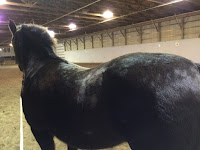Please note that much of this comes out of our own pockets, and any little donation made toward these needs, whether of funds or your time, enriches the lives of these horses and helps speed their recoveries.
If you are an experienced horse-person and are interested in volunteering to do any of the rehab work yourself, please email us at: MeadowlarkEquine@gmail.com
---
 Rowan
Rowan
Concerns:- Under Weight
- Poor Hoof Health
- Poor Digestive Health
- Scratches (fungus on lower legs)
- Soundness/Osteoarthritis
Wish List:
- Cool Calories
- Renew Gold
- Timothy/Alfalfa Hay Cubes
- Uckele Omega Hoof
- Probiotics (non-brand specific)
- MTG (for scratches removal)
- Devil's Claw (anti-inflammatory/joint supplement)
Physical Therapy List:
Regular Chiropractic Appointments - Keeps her aligned and mechanically correct through recovery
Hand-walking - Helps stimulate blood flow to her hooves, speeding their growth
Hill-walks - Hand walking up and down hills loosens the contracted muscles in her back
Brushing (she loves her mud!) - Stimulates blood flow, creates healthier skin/coat
Carrot Stretches - Helps to de-contract/relax multifidus muscles along her spine, as well as other muscles
Oiling/Picking at Scratches - Removal of scabs helps get air and blood flow to affected areas
Lunchtime Snacks - Rowan gets additional meals to help her gain weight (hay cubes, renew gold, etc)
---
 Marla
Marla
Concerns:- Over Weight
- Metabolic Disorder
- Ringbone/Osteoarthritis
- Allergies
Wish List:
- Joint Supplements
-
Physical Therapy List:
Hand-walking - Helps raise metabolism and burn calories
Carrot Stretches - Helps to de-contract/relax multifidus muscles along her spine, as well as other muscles
---
 Hazel
Hazel
Concerns:
- Sore, Contracted Back
- Flare in hooves (connected to dysfunction of back, in motion)
Wish List:
- Joint Supplements
- Omega Horse Shine
Physical Therapy List:
Regular Chiropractic Appointments - Keeps her aligned and mechanically correct through recovery
Carrot Stretches - Helps to de-contract/relax multifidus muscles along her spine, as well as other muscles
Lunging over poles - Engages abdominal muscles and lifts back
Hill-walks - Hand walking up and down hills loosens the contracted muscles in her back
Riding long-and-low - Increases comfort in lengthening spine
























